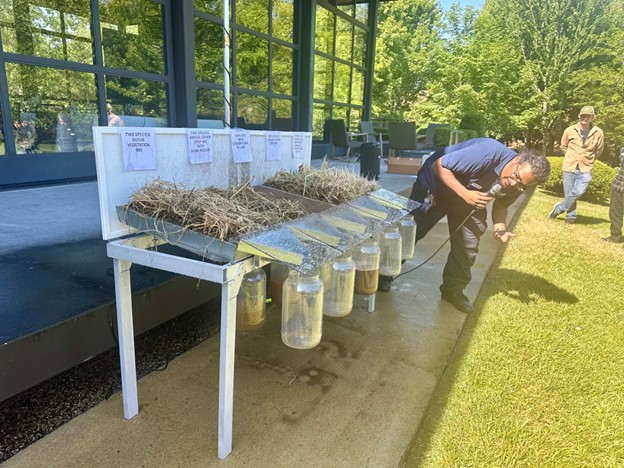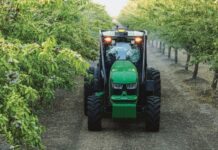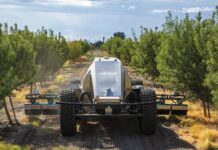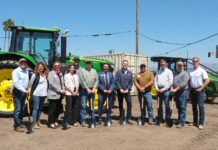
Winegrowers got a first look at the goals and practices involved in a major, pioneering, government-funded study of regenerative viticulture practices at a field day on June 21 at La Crema winery’s Windsor vineyard. UC Davis scientists and Jackson Family Wines viticulture managers presented the event, in which UC and other scientists are studying the impact of regenerative practices, such as no-till, compost, cover crops and more, applied in various combinations.
Principal Investigator Dr. Cristina Lazcano, associate professor in the UC Davis Dept. of Land, Air and Water Resources, said the study is novel because it’s looking at the synergies various regenerative viticulture practices provide when used in different combinations.
The study is funded by both public and private sources. USDA funded Foundation for Food and Agriculture $1 million, which was matched with a $1.5 million contribution by Jackson Family Wines. Additional funding came from CDFA’s specialty crop block grant. The project pairs an impressive group of scientists from UC and other institutions with the extensive vineyard holdings of Jackson Family Wines (the company is said to have 14,000 acres of vines.)
The word “regenerative agriculture” is defined by the project as “a toolkit of principles/practices to restore and preserve biodiversity and soil health by creating a functional ecosystem that reduces external inputs while producing nourishing farm products.”
Principles include keeping soil covered, minimizing soil disturbance, keeping continuously living plants/roots in the soil, optimizing biodiversity, integrating livestock and using carbon-based amendments. The study also includes a cost analysis.
The study will look at six unique combinations of treatments on 12 sites, situated on a variety of soil types and in varied climates, Lazcano said. At the end of five years, the researchers will measure the impact of the practices on soil microbial health.
“Honestly, as a researcher, it is a dream to be able to do this,” said Lazcano, “to try to understand the soil and climatic drivers of the effects of the practices. We’re going to be able to understand how a certain soil type has a different response from a different soil type and how these practices work in different climates.
“This has implications for how farmers are going to use the resources if they need more water, if they have more or less water, etc. The scale of the project is unique.”
The project is also novel in the way the researchers look at the practices, ”which is in a very comprehensive way,” Lazcano said. “Doing carbon analysis in the soil was the main reason why we started this, but then it has expanded. So now we are looking at water retention, and then water infiltration, nitrogen cycling in the soil. We’re looking at effects in the vines. So, the quality of the grapes, the yield, we’re looking at the economics. And we’re also doing the fermentation of the wines for the experiment.”
The study will do the same experiments in 12 different locations across the West Coast, she said, from trials on Jackson vineyards in Oregon’s Willamette Valley, where it is colder and rainier, to Sonoma, Monterey and Santa Barbara.
About 25 participants (plus scientists and Jackson staff) attended the half day event.
Axel Herrara, a postdoc at UC Davis in Lazcano’s lab, kicked off the sessions with an economic analysis from four Sonoma sites, showing little difference between conventional and regeneratively farmed sites in terms of profitability. Both had average life expectancies of 19 years. The annual operational cost between the two farming systems was less than $100 per acre.
Nall Inshan Moonilall, another postdoc researcher in the Lazcano lab, demonstrated the effects of water retention on bare soils compared to regenerative soil management, with the latter method increasing water filtration and preventing soil erosion and runoff.
Scarlett and Hector Viramontes integrate Dorper sheep into their vineyard management business. The South African breed does not feed on grapes, making management with electric fencing in vineyard rows feasible and practical. Breeding Dorpers is also far more profitable than raising meat sheep, they said.
Jan Sotomayor of Jackson Family Wines demonstrated the company’s industrial-sized compost equipment.
The event ended with a panel discussion of scientists and Jackson staff.
Said Scott Welch, director of farming for Jackson Family in Sonoma, Lake and Mendocino counties, “We just recently had a winegrowing summit that included all our winegrowing regions, from Oregon down to Santa Barbara, to talk about wine and vineyard production and the lofty goals we have for 2030. How do we approach that? Because we’ve made a fairly large claim talking about, you know, 100% of our vineyard acres using regenerative farming. And the big thing we found was changing the regenerative farming to more regenerative farming practices.
“Composting, multi-tillage, and cover crops were the three big buckets,” he said. “We’re doing those, and so the idea now is, ‘Okay, how do we continuously improve and build off that?’
“What we’re learning at events like we’ve had today, is how do we refine things… mowing used to be completely wiping out the row of existing vegetation,” Welch continued. “But now that we’re learning about keeping weeds alive, keeping roots established… there’s lots of areas where we’re going 12 to 16 inches off the ground, so trying to maintain green cover for an additional month, or two months, or however long that is.
“Another example would be with cover crops; rather than just using whatever’s available at Wilbur Ellis, it’s figuring out what suits your system,” he said. “In areas that are frost-prone, you might not have nitrogen fixing things because you’re going to mow it down early. And if it’s a drought year, those cover crops aren’t going to mature and really do enough for you to be worth the cost of the inputs.
“I think it’s taking a step back and doing the regenerative practices we’ve always done, but just modify them, refine them, so that we’re really pulling out the most from those practices,” he said.











